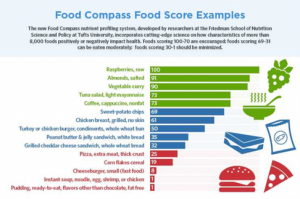This novel nutrient profiling system was developed by a soon-to-be advisor to the White House
Researchers at Tufts University have developed a novel nutrient profiling system called Food Compass. A Food Compass Score (FCS) between 1 and 100 (with 100 being the most healthful) can be assigned to nearly any food by evaluating foods across nine domains and using a unique algorithm to determine a score. A FCS of 70 or above represents foods and beverages to be encouraged. Foods scoring 31-69 are to be consumed in moderation, and a FCS of 30 or below are to be minimized.
These scores can be used internally by food manufacturers to improve formulations or by consumers to inform food choices.
I’ve written about some different food ranking apps before, and most just aren’t very evidence based and rely much too heavily on the appeal-to-nature fallacy to determine rankings. The Food Compass nutrient profiling system is a bit different, however, as it was developed by researchers at the Friedman School of Nutrition Science and Policy at Tufts University and is based on a study published in Nature Food on October 14, 2021.
Here’s a graphic from Tufts showing the scores for a handful of different foods:

At first glance, I noticed that sweet potato chips ranked above grilled chicken breast, which seemed a bit odd, but really the whole thing is problematic for the same reasons that all food ranking systems are problematic, and that is that individual foods aren’t eaten in isolation. The nutritional value and quality of the whole diet is what really matters, and ranking individual foods just doesn’t jive with that fact.
In fact, this whole ranking system had surfaced on social media this summer with articles like, Bill Gates-Funded Nutrition Scientist Says Reese’s Cups Are Healthier Than Beef.
So, what happens if you compare the rankings of a handful of different foods? That’s exactly what critics of the Food Compass recently have done in this preprint titled Limitations of the Food Compass Nutrient Profiling System. You can find updated rankings here:
Food Compass fixed errors in its algorithm. Good news, sweet potato fries are now in the green ?https://t.co/zHniNbRLXg pic.twitter.com/3JFEJxuwJI
— Ty Beal (@TyRBeal) August 12, 2022
The first thing that stuck out to me was that whole milk was ranked below Lucky Charms cereal. So, Lucky Charms on their own would rank higher than a bowl of lucky charms with whole milk, even though the milk would add fat and protein and keep you fuller for longer.
Not to mention that unsweetened almond milk is given a score of 82, while whole milk is at a mere 46. Again, the whole milk is going to provide additional fat and protein to keep one fuller for longer than unsweetened almond milk, which isn’t a bad option, but I certainly don’t see how it gets almost twice the score of whole milk. Fat-free milk is in between with a score of 64, so still 18 points lower than the unsweetened almond milk. Notice also that egg substitute fried in vegetable oil scores an additional 21 points to a boiled or poached egg and is over 2.5 times the score of the measly 26 garnered by ground beef.
Now, you know I’d be the first to debunk myths regarding vegetable oils as well as meat and egg substitutes, but that doesn’t mean they’re significantly healthier than their animal-based alternatives. This begs the question of what metrics were used to get here?
Food Compass scores 54 attributes across nine health-relevant domains: nutrient ratios, vitamins, minerals, food ingredients, additives, processing, specific lipids, fiber and protein, and phytochemicals. It assigns a -10 to +10 points depending on these specific attributes. The nutrient ratios include unsaturated:saturated fat ratio, fiber:carbohydrate ratio, and potassium:sodium ratio. The greater the ratio, the greater the score for that specific attribute. Next are vitamins and minerals, where foods with 25 percent of the RDA and above get the full 10 points down to zero percent, which gets zero points. Fiber and protein are assigned points similarly.
The presence of phytochemicals can also increase the score of a food up to 10 points for flavonoids and 10 points for carotenoids, depending on the amount in the food. Foods containing refined grains, red or processed meats and added sugars are penalized -10 to 0 points, depending on the amount in the food. Foods containing fruits, non-starchy vegetables, beans and legumes, whole grains, nuts and seeds, seafood, yogurt and plant oils are given 0 to 10 points for each of these ingredients, depending on the level in the food. Foods containing nitrites, artificial sweeteners, flavors or colors, partially hydrogenated oils, interesterified or hydrogenated oils, high fructose corn syrup (HFCS) and monosodium glutamate (MSG) are penalized -10 points for the existence of each of these additives in the food.
The specific lipids scoring subtracts up to 10 points each for cholesterol and trans fats and adds up to 10 points each for medium chain fatty acids (MCFAs), alpha-linolenic acid (ALA) and eicosapentaenoic acid (EPA) + docosahexaenoic acid (DHA), depending on the amounts in the food. Up to 10 points can be subtracted depending on the degree of processing as well. Fermented foods get an extra 10 points, while fried foods get 10 points subtracted from their score.

Some of the scoring seems reasonable, but some of it doesn’t. To subtract additional points for one specific source of added sugars, HFCS, but not for others when it simply is a source of added fructose and glucose just like honey, table sugar, and many other sources of added sugars, makes entirely no scientific sense. Not to mention that points were already subtracted for added sugars in the first place. This scoring seems to exaggerate the risks associated with animal-based foods as well as particular food additives including HFCS, MSG, artificial sweeteners, flavors, and colors. Phytochemicals are assigned the same weight as protein and fiber, despite the evidence regarding health effects from these domains not being comparable. Differences in bioavailability of nutrients is not accounted for and protein quality of foods isn’t either.
Processed meat and red meat are weighted the same despite the available evidence showing a difference in consumption associated risk. Seafood and yogurt are the only animal-based foods included in the list of healthful food ingredients, while milk and eggs are excluded despite making a significant contribution to diet quality. Lastly, additives like partially hydrogenated oils (trans fats) are weighted the same as MSG, HFCS, artificial sweeteners, flavors, and colors despite the evidence regarding health effects from these additives being very different.
Food Compass incorporates a broader range of food characteristics, novel attributes and uniform scoring principles than other nutrient profiling systems (NPS), with demonstrated content, convergent and discriminant validity. It aims to increase objectivity, allow for direct comparison across items and facilitate the assessment of mixed dishes.
Despite these improvements over previous NPS, assessing the healthfulness of foods based on a single scale may not be appropriate. Healthy diets can be achieved in many different ways by combining food items from different food groups and in differing quantities. Overall diet quality and its effects on health may not be able to be captured by simply assessing health effects of individual foods.
Dr. Dariush Mozaffarian, dean of Tufts University’s Friedman School of Nutrition Science and Policy and Food Compass project lead, has long called for change in our food system and federal nutrition strategy. This September, for the first time in over 50 years, the White House will host a Conference on Hunger, Nutrition and Health. He is a co-chair of the Task Force on Hunger, Nutrition, and Health, which will informing the White House conference along with Chef José Andrés, Ambassador Ertharin Cousin, Sen. Bill Frist, and former Ag Secretary Dan Glickman.
Their mission is “reimagining our nation’s food system to end hunger, improve nutrition, and reduce diet-related chronic diseases.” The conference pillars are: “Improve food access and affordability; integrate nutrition and health; empower all consumers to make and have access to healthy choices; support physical activity for all; and enhance nutrition and food security research.”
The previous White House conference on hunger was held in 1969 at the start of the Nixon administration and helped to greatly expand the Food Stamp Program and School Lunch Program, authorization of the Supplemental Feeding Program for Women Infants and Children, and improvements to nutrition labeling and ingredient labeling. With food inflation outpacing salary growth and food insecurity on the rise, especially among younger generations and in households with children, this conference seems long overdue.
While we have yet to see what the outcomes of this long awaited conference will be, according to former Agriculture Secretary Dan Glickman the questions likely to be examined at the conference will be, “How do we best get food to hungry people — whether it’s through our food banking system, or through our SNAP program or other federal programs? Are they working well? Is there proper coordination? Is there enough flexibility in those programs?” The second part “is going to be, how can we find out more about nutrition, about what foods actually make you and keep you healthy.” That second part is where Food Compass could play a role. It’s a bit concerning if “what foods actually make you and keep you healthy” is going to be influenced by a nutrient profiling system project led by one of the Task Force co-chairs that clearly has some significant flaws.
Food Science Babe is the pseudonym of an agvocate and writer who focuses specifically on the science behind our food. She has a degree in chemical engineering and has worked in the food industry for more than decade, both in the conventional and in the natural/organic sectors.



